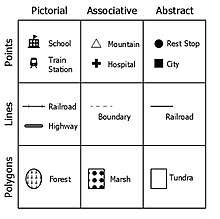Symbol
A symbol is a mark, sign, or word that indicates, signifies, or is understood as representing an idea, object, or relationship. Symbols allow people to go beyond what is known or seen by creating linkages between otherwise very different concepts and experiences. All communication (and data processing) is achieved through the use of symbols. Symbols take the form of words, sounds, gestures, ideas, or visual images and are used to convey other ideas and beliefs. For example, a red octagon is a common symbol for "STOP"; on maps, blue lines often represent rivers; and a red rose often symbolizes love and compassion. Numerals are symbols for numbers; letters of an alphabet may be symbols for certain phonemes; and personal names are symbols representing individuals. The variable 'x', in a mathematical equation, may symbolize the position of a particle in space.


The academic study of symbols is semiotics. In cartography, an organized collection of symbols forms a legend for a map.
Etymology
The word symbol derives from the Greek σύμβολον symbolon, meaning "token, watchword" from σύν syn "together" and βάλλω bállō " "I throw, put." The sense evolution in Greek is from "throwing things together" to "contrasting" to "comparing" to "token used in comparisons to determine if something is genuine." Hence, "outward sign" of something. The meaning "something which stands for something else" was first recorded in 1590, in Edmund Spenser's Faerie Queene.[1]
Concepts and definitions
Symbols are a means of complex communication that often can have multiple levels of meaning.[2] Symbols are the basis of all human understanding and serve as vehicles of conception for all human knowledge.[3] Symbols facilitate understanding of the world in which we live, thus serving as the grounds upon which we make judgments.[4] In this way, people use symbols not only to make sense of the world around them, but also to identify and cooperate in society through constitutive rhetoric.
Human cultures use symbols to express specific ideologies and social structures and to represent aspects of their specific culture. Thus, symbols carry meanings that depend upon one's cultural background; in other words, the meaning of a symbol is not inherent in the symbol itself but is culturally learned.[2]
Heinrich Zimmer gives a concise overview of the nature, and perennial relevance, of symbols.
Concepts and words are symbols, just as visions, rituals, and images are; so too are the manners and customs of daily life. Through all of these a transcendent reality is mirrored. There are so many metaphors reflecting and implying something which, though thus variously expressed, is ineffable, though thus rendered multiform, remains inscrutable. Symbols hold the mind to truth but are not themselves the truth, hence it is delusory to borrow them. Each civilisation, every age, must bring forth its own."[5]
In the book Signs and Symbols, it is stated that
A symbol ... is a visual image or sign representing an idea -- a deeper indicator of universal truth.[6]
Symbols and semiotics
Semiotics is the study of signs, symbols, and signification as communicative behavior. Semiotics studies focus on the relationship of the signifier and the signified, also taking into account the interpretation of visual cues, body language, sound, and other contextual clues. Semiotics is linked with both linguistics and psychology. Semioticians thus not only study what a symbol implies but also how it got its meaning and how it functions to make meaning in society. Symbols allow the human brain continuously to create meaning using sensory input and decode symbols through both denotation and connotation.
Psychoanalysis, rhetoric, and archetypes
An alternative definition of symbol, distinguishing it from the term sign was proposed by Swiss psychoanalyst Carl Jung. In his studies on what is now called Jungian archetypes, a sign stands for something known, as a word stands for its referent. He contrasted a sign with a symbol: something that is unknown and that cannot be made clear or precise. An example of a symbol in this sense is Christ as a symbol of the archetype called self.[7]
Kenneth Burke described Homo sapiens as a "symbol-using, symbol making, and symbol misusing animal" to suggest that a person creates symbols as well as misuses them. One example he uses to indicate what he means by the misuse of symbol is the story of a man who, when told that a particular food item was whale blubber, could barely keep from throwing it up. Later, his friend discovered it was actually just a dumpling. But the man's reaction was a direct consequence of the symbol of "blubber" representing something inedible in his mind. In addition, the symbol of "blubber" was created by the man through various kinds of learning.
Burke goes on to describe symbols as also being derived from Sigmund Freud's work on condensation and displacement, further stating that symbols are not just relevant to the theory of dreams but also to "normal symbol systems". He says they are related through "substitution", where one word, phrase, or symbol is substituted for another in order to change the meaning. In other words, if one person does not understand a certain word or phrase, another person may substitute a synonym or symbol in order to get the meaning across. However, upon learning the new way of interpreting a specific symbol, the person may change his or her already-formed ideas to incorporate the new information.
Jean Dalby Clift says that people not only add their own interpretations to symbols, they also create personal symbols that represent their own understanding of their lives: what she calls "core images" of the person. She argues that symbolic work with these personal symbols or core images can be as useful as working with dream symbols in psychoanalysis or counseling.[8]
William Indick suggests that the symbols that are commonly found in myth, legend, and fantasy fulfill psychological functions and hence are why archetypes such as "the hero," "the princess" and "the witch" have remained popular for centuries.[9]
Symbolic value
Symbols can carry symbolic value in three primary forms: Ideological, comparative, and isomorphic.[10] Ideological symbols such as religious and state symbols convey complex sets of beliefs and ideas that indicate "the right thing to do". Comparative symbols such as prestigious office addresses, fine art, and prominent awards indicate answers to questions of "better or worse" and "superior or inferior". Isomorphic symbols blend in with the surrounding cultural environment such that they enable individuals and organizations to conform to their surroundings and evade social and political scrutiny. Examples of symbols with isomorphic value include wearing a professional dress during business meetings, shaking hands to greet others in the West, or bowing to greet others in the East. A single symbol can carry multiple distinct meanings such that it provides multiple types of symbolic value.[10]
Paul Tillich
Paul Tillich argued that, while signs are invented and forgotten, symbols are born and die.[11] There are, therefore, dead and living symbols. A living symbol can reveal to an individual hidden levels of meaning and transcendent or religious realities. For Tillich a symbol always "points beyond itself" to something that is unquantifiable and mysterious; symbols open up the "depth dimension of reality itself".[12] Symbols are complex, and their meanings can evolve as the individual or culture evolves. When a symbol loses its meaning and power for an individual or culture, it becomes a dead symbol. When a symbol becomes identified with the deeper reality to which it refers, it becomes idolatrous as the "symbol is taken for reality." The symbol itself is substituted for the deeper meaning it intends to convey. The unique nature of a symbol is that it gives access to deeper layers of reality which are otherwise inaccessible.[13]
Role of context in symbolism
A symbol's meaning may be modified by various factors including popular usage, history, and contextual intent.
Historical meaning
The history of a symbol is one of many factors in determining a particular symbol's apparent meaning. Consequently, symbols with emotive power carry problems analogous to false etymologies.[14]
Context
The context of a symbol may change its meaning. Similar five-pointed stars might signify a law enforcement officer or a member of the armed services, depending upon the uniform.
Symbols in cartography

Symbols are used in cartography to communicate geographical information (generally as point, line, or area features).[15] As with other symbols, visual variables such as size, shape, orientation, texture, and pattern provide meaning to the symbol.[16] According to semiotics, map symbols are "read" by map users when they make a connection between the graphic mark on the map (the sign), a general concept (the interpretant), and a particular feature of the real world (the referent). Map symbols can thus be categorized by how they suggest this connection:[17][18]
- Pictorial symbols (also "image", "iconic", or "replicative") appear as the real-world feature, although it is often in a generalized manner; e.g. a tree icon to represent a forest, or green denoting vegetation.
- Functional symbols (also "representational") directly represent the activity that takes place at the represented feature; e.g. a picture of a skier to represent a ski resort or a tent to represent a campground.
- Conceptual symbols directly represent a concept related to the represented feature; e.g. a dollar sign to represent an ATM, or a Star of David to represent a Jewish synagogue.
- Conventional symbols (also "associative") do not have any intuitive relationship but are so commonly used that map readers eventually learn to recognize them; e.g. a red line to represent a highway or a cross to represent a hospital.
- Abstract/geometric symbols (also "adhHoc") are arbitrary shapes chosen by the cartographer to represent a certain feature.
Related terms
A symbolic action is an action that has no, or little, practical effect but symbolizes, or signals, what the actor wants or believes. The action conveys meaning to the viewers. Symbolic action may overlap with symbolic speech, such as the use of flag burning to express hostility or saluting the flag to express patriotism.[19] In response to intense public criticism, businesses, organizations, and governments may take symbolic actions rather than, or in addition to, directly addressing the identified problems.[20]
See also
- Alchemical symbol
- Astrological symbols
- Astronomical symbols
- Emblem
- Icon (religious) and secular icon
- List of symbols
- Logo
- National symbol
- National treasure
- Proto-writing
- Sign
- Symbolic interactionism
- Symbolism (arts)
- Table of mathematical symbols
- Traffic signs
- Unicode symbols
- Universal language
References
- Online Etymological Dictionary
- Womack, Mari. Symbols and Meaning: A Concise Introduction. California: AltaMira Press, 2005.
- Langer, Susanne K. A Theory of Art, Developed From: Philosophy in a New Key. New York: Charles Scribner’s Sons, 1953.
- Palczewski, Catherine, and Ice, Richard, and Fritch, John. Rhetoric in Civic Life. Pennsylvania: Strata Publishing, Inc., 2012.
- Campbell, Heinrich Zimmer; edited by Joseph (1969). Philosophies of India (9. paperback print. ed.). Princeton: Princeton Univ. Press. pp. 1–2. ISBN 0-691-01758-1.
- Dorling Kindersley Limited. Signs and Symbols. p.6. ISBN 978-0-7566-3393-6. 2008
- Christ, A symbol of the self CW vol 9i Aion RKP 1958
- Jean Dalby Clift, Core Images of the Self: A Symbolic Approach to Healing and Wholeness. Crossroad, 1992.
- Indick, William. Ancient Symbology in Fantasy Literature: A Psychological Study. Jefferson: McFarland &, 2012. Print.
- Schnackenberg, Andrew K.; Bundy, Jonathan; Coen, Corinne; Westphal, James (2019). "Capitalizing on Categories of Social Construction: A Review and Integration of Organizational Research on Symbolic Management Strategies". Academy of Management Annals. 13 (2): 375–413. doi:10.5465/annals.2017.0096.CS1 maint: ref=harv (link)
- Tillich, Paul (1964). Theology of Culture. Oxford University Press. pp. 58. ISBN 0195007115.
- Tillich, Paul (1964). Theology of Culture. Oxford University Press. pp. 59. ISBN 0195007115.
- Tillich, Paul (1964). Theology of Culture. Oxford University Press. pp. 54. ISBN 0195007115.
-
Compare:
Basso, Michele (1982). Eschatological symbolism in the Vatican Necropolis. Tipografia Poliglotta Vaticana. p. 700. Retrieved 2019-01-05.
In a late period the Greeks made [Pan] the incarnation of All (giving a false etymology to his name, which is really connected with the pastures), that is to say, the universe.
- Tyner, Judith A. (2010). Principles of map design. New York: Guilford Press. ISBN 9781606235447. OCLC 437300476.
- Dent, Borden D.; Torguson, Jeffrey; Hodler, T. W. (2008-08-21). Cartography : thematic map design (6th ed.). New York: McGraw-Hill Higher Education. ISBN 978-0072943825. OCLC 184827987.
- MacEachren, Alan (1995) How Maps Work: Representation, visualization, and design, New York: Guilford Press
- Dent, Borden D. (1999). Cartography : thematic map design (5th ed.). New York: McGraw-Hill Higher Education. ISBN 0697384950.
- Bagossy, Renate. The Difficulty of the Amendment Process of the Constitution of the United States of America and Freedom of Speech and its limits. GRIN Verlag; 2008-08-11 [cited 5 November 2012]. ISBN 9783640129546. p. 16–17.
- Bednar, Michael Kay. How Symbolic Action Affects the Media as a Governance Mechanism. ProQuest; 2008. ISBN 9780549738817. p. 17.
External links
| Look up symbol in Wiktionary, the free dictionary. |
| Wikiquote has quotations related to: Symbols |
| Wikimedia Commons has media related to Symbols. |
